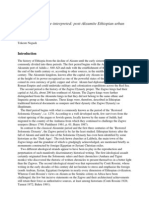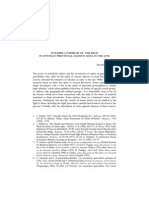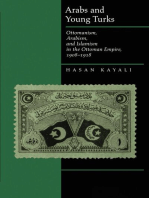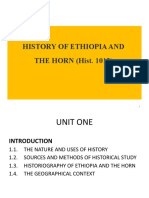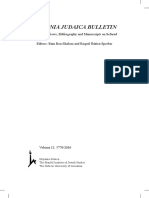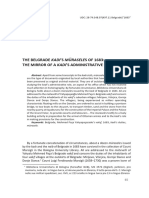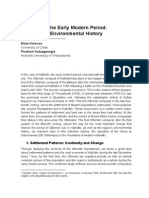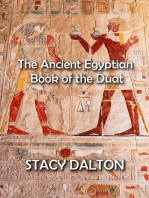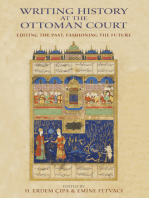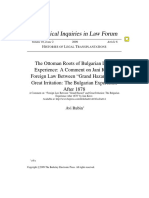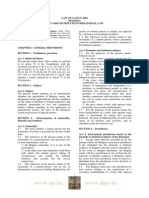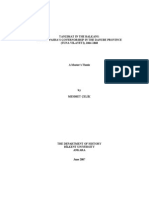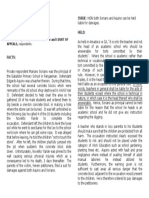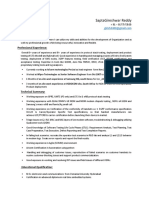Professional Documents
Culture Documents
Tapu Title Deeds
Uploaded by
mandragoraOriginal Description:
Copyright
Available Formats
Share this document
Did you find this document useful?
Is this content inappropriate?
Report this DocumentCopyright:
Available Formats
Tapu Title Deeds
Uploaded by
mandragoraCopyright:
Available Formats
Islamic Law and Society 7, 1 (2000)
OTTOMAN TAPU TITLE DEEDS IN THE EIGHTEENTH AND NINETEENTH CENTURIES: ORIGIN, TYPOLOGY AND DIPLOMATICS* ANTON MINKOV (McGill University)
Abstract
Although the existence of the tapus is well known, their typology, formulary and structure have not been an object of detailed analysis. In this article, based on research undertaken in the Ottoman archive of the National Library of Bulgaria, I analyze eighteenth- and nineteenth-century Ottoman tapu title deeds. I argue that their classical eighteenth- and nineteenth-century form is the outcome of the amalgamation of (1) receipts for payment of the tapu fee (resm-i tapu) and (2) records of land transfer. I also argue that the process of amalgamation started probably in the middle of the sixteenth century and continued until the second half of the seventeenth century.
Introduction THE DEMISE OF THE TOTALITARIAN REGIME in Bulgaria in 1989 and the subsequent land restitution, a number of people approached me for translations of Ottoman land title deeds (tapu). The holders of the title deeds hoped to reclaim their lands with the help of these documents, despite the fact that the title deeds were issued many years agobetween the 1860s and 1910and by a state that no longer existed. Although I do not know whether they were successful or not, I was intrigued by the fact that one generation after another had preserved the tapu title deeds as proof of family landholdings. Motivated by my belief that scholars have not given adequate attention to tapus, I undertook a research on these documents. Tapu is a familiar term for scholars of Ottoman land law and society. It is associated with the peculiarities of holding agricultural land in the Ottoman empire, i.e., the miri land regime.1 In a broad sense, the term tapu is used to describe the general system of
I would like to express my gratitude to Dr. Stoyanka Kenderova, who helped me in the research on the tapu title deeds; to Prof. Wael Hallaq, who encouraged me to write this essay; to Prof. David Powers who edited the manuscript; and to the two external readers for their valuable comments and suggestions. Note on transliteration: In the essay, I use modern Turkish for the spelling of Ottoman terms and names of Arabic origin as well as for the transliteration of Ottoman documents in the Appendix, i.e., no diacritical marks, except ayn as an apostrophe in middle of names, e.g., Abussuud. An apostrophe is also used to separate proper names from the case suffix in the transliterations, e.g. Petkonun. Occasionally, if a term of Arabic origin is discussed in a pre-Ottoman context or the modern Turkish spelling differs substantially from its Arabic transliterated form, the latter form is given as well. 1 The miri regime, i.e., state ownership of land, in the Ottoman empire is best described in the writings of Halil Inalck. For a summary of his views, see An Economic and Social History of the Ottoman Empire 1300-1914, ed. H. Inalck and D. Quataert (Cambridge 1994), 103-78 (henceforth History). See also Colin Imber, Ebus-suud: The Islamic Legal Tradition (Edinburgh, 1997), 115-38. For a slightly different view, see J.R. Barnes, An Introduction to Religious Foundations in the Ottoman Empire (Leiden, 1986), 21-49. For a description of the miri regime from a Marxist materialist point of view, see Vera Moutafchieva, Agrarian Relations in the Ottoman Empire in the 15th and 16th centuries (New York, 1988).
*
FOLLOWING
Islamic Law and Society 7, 1 (2000)
peasant land tenurethe tapu systemin lands which the Ottoman law codes (kanunnames) specify as held by tapu (tapulu lands).2 In this sense tapu is rightly regarded as an Ottoman fiscal institution.3 In a narrow sense, tapu, shorthand for resm-i tapu, designates the amount payable upon taking possession of a plot of land.4 Lastly, as shorthand for tapuname or tapu senedi, the word tapu defines the documenttitle deedby which an inhabitant of the Ottoman empire could prove his right of usufruct (hakk- tasarruf) to the miri land in his possession.5 Based on information contained in Ottoman kanunnames from the fifteenth and sixteenth centuries,6 scholars have determined who has the right to obtain a tapu, the legal rights and obligations of a tapuholder vis--vis the state and its representatives, and other matters relating to the operation of the tapu system.7 Although the existence of the tapu title deeds is well known, scholars have not studied their form and structure, typology, changes over time, and the relationship between such changes and changes in land tenure.8 In this essay, I discuss the different types of tapus and their diplomatic features in the eighteenth and nineteenth centuries, along with Ottoman land law dealing with matters related to tapus. Using information contained in court records, kanunnames and some early documents at my disposal, I also discuss the origin and development of tapus. In my opinion, the refinement of Ottoman land law in the middle of the sixteenth century stimulated the consequent development of tapus. I argue that the classical eighteenth- and nineteenth-century form of the tapu title deeds is the result of the amalgamation of two types of documents: receipts for payment of the tapu fee (resm-i tapu) and records of land transfer. I also argue that the amalgamation process began around the middle of the sixteenth century, and was completed only in the second half of the seventeenth century. Therefore, references in the scholarly literature to tapu as a title deed in the fifteenth and sixteenth centuries are not historically accurate. Sources One of the reasons for the scholarly neglect of tapus as documents is the paucity of sources. Prior to 1858, only one copy of a tapu was written and it was given to the peasant. Upon transfer of land, the old tapu was invalidated. It is thus not surprising that few tapus issued before the Land Code of 1858 have survived. These were preserved not
See History, 110 and H. Inalck, Village, Peasant and Empire, in idem, The Middle East and the Balkans under the Ottoman Empire: essays on economy and society (Bloomington, 1992), 143. 3 J. Schacht, Introduction to Islamic Law (Oxford, 1964), 90. 4 Suraiya Faroqhi, EI2, s.v. Tapu, and Haim Gerber, The Social Origins of the Modern Middle East (Boulder, 1987), 22-24. 5 Faroqhi, Tapu. See also Bruce McGowan, Economic Life in Ottoman Europe. Taxation, Trade and the Struggle for Land, 1600-1800 (Cambridge, 1981), 220, where tapu is described as a deed-like land transfer document issued by timar holder. 6 For published kanunnames from the fifteenth and sixteenth centuries, see . L. Barkan, XV. ve XVI. Asrlarda Osmanl mparatorluunda Zira Ekonominin Hukuk ve Mali Esaslar, I: Kanunlar (Istanbul, 1943). A new and more comprehensive collection of kanunnames is published in Osmanl Kanunnmeleri ve Hukuk Tahlilleri, ed. Ahmed Akgndz (Istanbul, 1990). 7 See the literature cited in note 1. 8 Fani Milkova, Pozemlenata sobstvenost v bulgarskite zemi prez 19 vek (Sofia, 1970) and Jivko Stalev, Notarialniat akt, in Godishnik na SU-UF (Sofia, 1943) discuss the development of tapu in the nineteenth century. The similarity of older tapus to a contract of sale as drawn up in court records has only recently been notedsee History, 109.
2
Islamic Law and Society 7, 1 (2000)
in central archives but in private hands or in small collections in villages; only recently have state archives or smaller regional archives acquired extant documents.9 I have found only a handful of older tapus in the archive of the National Library of Bulgaria, most of them from the eighteenth and the first half of the nineteenth centuries.10 Tapus from the nineteenth century are more often found in the archives, since, following the Land Code of 1858, one copy of each tapu title deed was held in the Imperial Cadastral office (Defterhane-i hakani) and one copy in the provincial registry office. Consequently, the nineteenth-century tapu occasionally finds its way into scholarly publications.11 For the present study I have examined, in addition to the published tapus, approximately 100 post-1858 tapus, including some early twentieth-century tapus, preserved in the archives of the National Library of Bulgaria12 as well as in private hands. All the documents that I examined come from the Balkans and more specifically from the territories of present-day Bulgaria, Romania, Eastern Serbia, Eastern Macedonia, Northern Greece and European Turkey. I believe that prior to 185813 tapu title deeds were issued throughout the Balkans and Anatolia,14 and, perhaps, in those regions of Syria15 in which regions the miri regime was in place.16 To my knowledge, no tapus from the western part of the Balkans, Anatolia and Syria have been published. I realize that my conclusions about Ottoman tapu title deeds will remain limited in nature until such time as documents from these regions have come to light.
See, for example, the catalogue of Ottoman documents in the archive of the town of Belovo in the Rhodope mountainsE. Grozdanova, Osmanoturski documenti of arhivnata zbirka na gr. Belovo za istoriyata na rodopskiya krai, in Recueil du Rhodope V (Sofia, 1983), 269-86which includes twenty-two tapus from the eighteenth century. See also the catalogue of the archive of Ottoman documents in the Rila MonasteryD. Ihtchiev, Turskite documenti na Rilskiya manstir (Sofia, 1910)which contains some 150 tapus from the eighteenth and the nineteenth centuries. 10 See National Library SS. Cyril and Methodious (NBKM), collections LV 11/12, BR 4/6, 73A/80, TCH 66/22. 11 There are, for example, nine facsimiles of nineteenth-century tapus in Milkova, Pozemlenata sobstvenost, nine facsimiles in A. Velkov, Vidove osmanoturski dokumenti: Prinos kam osmanoturskata diplomatika (Sofia, 1986), four facsimiles in G. Galabov, Po nyakoi vaprosi na turskoto feodalno zemevladenie, Izvestiya na Ikonomicheskiya institut 9, 1-2 (1955) and one facsimile in M. Gubolu, Paleografia i diplomatica turco-osmana: Studici i album (Bukuresti, 1959). 12 See NBKM, collections 73A/81, SM 5/9, OAK 252/ 28, 191A/19, PD 2/117-118, TRN 37/66. 13 The Land Code of 1858 instituted the application of tapu title deeds in all Ottoman territories. 14 In her study of land transfers in central Anatolia, based on court records from the end of the sixteenth century, Suraiya Faroqhi found legal procedures relating to land transfers, one of the main applications of tapu, similar to those observed in the Balkans. See Suraiya Faroqhi, Land transfer, Land disputes and askeri holdings in Ankara (1592-1600), in Mmorial mer Ltfi Barkan (Paris, 1980), 87-100. 15 Agricultural conditions similar to those in the Balkans and Anatolia, i.e. grain cultivation with dry farming, existed in parts of Syria and Iraq (History, 156). I thank Prof. Baber Johansen for informing me that the Syrian jurist Ibn Abidin (al-Uqd al-durriyya, vol. II) discusses the payment of the tapu fee and different questions associated with it, e.g., inheritance rights according to the tapu regime, the nature of the tapu fee, possession rights given by the payment of the tapu fee, etc. 16 The court records of eighteenth-century Lower Egypt point to peasant landholding not much different from that of the core Ottoman areas, see Kenneth Cuno, The Pashas Peasants: Land, Society and Economy in Lower Egypt 1740-1858 (Cambridge, 1992). There is no indication, however, that a tapu regime, as it is known in the Balkans and Anatolia, was implemented in Egypt. I do not believe that tapu title deeds existed there.
Islamic Law and Society 7, 1 (2000)
Types of tapu title deeds The pre-1858 tapus that I have examined are similar in their form and structure. A distinguishing feature of these documents, which were issued by local intermediaries, is the presence of textual variations. The Land code of 1858 was a milestone in the development of the tapu title deeds. By changing the fiscal relation of the peasants to the state from indirect tax collectionthrough intermediariesto direct responsibility for payment of taxes, the Code brought about changes in the form and structure of the document. First, by centralizing the administrative procedure, the state acquired the prerogative to issue tapus through the Imperial Cadastral office (Defterhane-i hakani). Second, the introduction of printed forms into chancery practice eliminated textual variations. The appearance of grid-like documents in the 1860s changed the look of the tapu completely. Therefore, I distinguish two types of tapusold type (issued before 1858) and new type (issued after 1858).17 Tapu types according to land categories When discussing the different types of tapu, it is important to keep in mind that the tapu system of land tenure reflected and regulated a particular peasant mode of production (ift-hane) which enabled the peasant farm (iftlik) to be exploited in an autonomous and systematic fashion by peasant families (hane). This mode of production, in turn, is connected to the agricultural characteristics of land, and, for this reason, it transcended the categories of ownership used by Muslim jurists. Thus, the tapu system of land tenure could exist regardless of how the land of a particular area was designated by Ottoman jurists. Indeed, we find tapus issued for miri, vakf and even mlk lands. 1. Tapus for miri lands The miri lands prevailed in the land system of the Ottoman empire, and it might therefore be assumed that these were the most common type of tapus. As noted, prior to 1858, the tapus for miri lands were issued by intermediariessipahi, mltezim or another local administrator; after 1858, they were issued by the Defterhane-i hakani. The introduction of printed forms changed the graphical layout of the new type tapus for miri land. The placement of the titles Arazi-i miriye and Tapu senedi under the sultans tura (the latter was a new element) clearly demonstrated that the document was for state lands. There were also some changes in the text of the document. The collection of a tapu fee by the person who issued the document was no longer mentioned. Instead, the document stipulated the regular payment of the tithe to the state, represented by a state official. 2. Tapus for vakf land In the old type tapus, the only mark that distinguished tapus for vakf land from those issued for miri land was mention of the vakf to which the land belonged and of the fact that the tapu fee was collected on behalf of the vakf. In the new type tapus, at the top of
17
See Appendix: Documents Five and Six for examples of an old type and a new type tapu.
Islamic Law and Society 7, 1 (2000)
the document, under the sultans tura, we find the title [Issued] by the Ministry of Imperial Vakfs (An canib-i nezaret-i evkaf- humayn). As in tapus for miri land, the collection of resm-i tapu was replaced by the condition of paying the tithe to the vakf. In the last quarter of the nineteenth century, the Defterhane-i hakani began to issue the tapus for vakf lands. Consequently, the only difference between title deeds for miri and vakf land was the mention of the vakfs title and the use of the word temessk instead of tapu. 2. Tapus for mlk land Tapus were issued for land and other properties located within the boundaries of populated areas, which, according to Ottoman law, were considered private property (mlk): orchards, vineyards, vegetable gardens, houses and arable land up to half a dnm. According to Vera Moutafchieva, this phenomenon relates to the states desire to increase revenues.18 This is plausible, as is her conclusion that the issuance of tapus for mlk lands inevitably led to a blurring of the distinction between mlk and miri lands.19 However, one must also consider the fact that the tapu was the only legal proof that a peasant could produce if a sipahi or other official violated his rights, or in the event of a property dispute. One may even argue that it was in the interest of the peasant to hold a tapu for his farm and village property20 because the document gave him the sense that the farm was his property.21 The Land Code of 1858 and, especially, the By-law for Issuing Certificates of Private Property of 1874, differentiated title deeds for mlk land from other tapu title deeds by emphasizing that the former applied to land held in private property. In such a document, one finds under the sultans tura the title phrase Official document [issued] for the possession of private property (emlak tasarrufuna mahsus senedi resmidir); and in the text one finds it is the private property of (mal ve mlk olmu olmakla). And at the end of the document one finds, the current document was issued in order to prove the right to own [the land] in private property (mlkiyet zabt etmek zere temliini mbeyyin ibu sened ita klnd). Tapu title deeds according to the reason of issuance A tapu may be issued on several occasions: initial granting of land, inheritance, transfer of land, renewal of an old or lost document, indisputable possession of land for a period of ten years, and reclaiming of barren land.
Moutafchieva, Relations, 5. Ibid. See also Gerber, Origins, 12. 20 For a similar conclusion with regard to peasants in Lebanon, see Wael B. Hallaq, Model Shurut Works and the Dialectic of Doctrine and Practice, Islamic Law and Society, 2 (1995), 117. 21 The numerous land disputes in the Balkans and Anatolia described in the legal as well as in the fictional literature of the period point to a strong sense of ownership. Clearly, Balkan and Anatolian peasants believed that the land belonged to them, not to the state or its representative. For a similar observation with regard to Russian peasants, see Richard Pipes, Russia under the Old Regime (London, 1974), 150-53.
19
18
Islamic Law and Society 7, 1 (2000)
1. Tapus for initial granting of land Granting land through the instrument of tapu should be understood in the context of the Hanafi concept of ownership, which distinguishes between ownership of the substance (rakabe) and ownership of the usufruct (tasarruf). According to fetvas22 of the Ottoman jurist Abussuud (d. 1574), what was granted to the peasant was actually the usufruct or the right of use of the land (tasarruf).23 Abussuud regarded peasant use of land as a lease (icare) and the payment collected by the state representative (resm-i tapu) as rent paid in advance (cret-i muaccele).24 A tapu for the initial granting of land was issued when the state or the vakf, which held formal title to the land (rakabe), granted vacant (mahll) or abandoned (muattal) land (through its representativesipahi, mltezim or mtevelli) to a peasant. The initial granting of land also occurred when a tapu-holder disappeared or died without heirs and close relatives who, according to the law, could claim the right of tapu (hakk- tapu).25 In such cases, anyone living in the area might be a prospective candidate.26 He could request the vacant land by claiming right by virtue of residence (hakk- karar)27 and by paying a feeresm-i tapu. Disinterested Muslims determined the amount of the resm-i tapu.28 Although, the fee was formally limited to a maximum of one-years income from the land after the land tax,29 there are reasons to believe that the resm-i tapu reflected the market value of the land described in the tapu.30 The law did not allow giving land to someone not residing in the village.31 The sipahi also had the right to take the land from a peasant who did not cultivate it for more than three years and to give it to someone else or to demand another tapu fee from the previous holder.32
These fetvas, which were included in the kanunnames, greatly influenced the subsequent development of Ottoman land law. For the text of the most important fetvas concerning land law, see Arazi ile Alkal Ebssud ve bn-i Kemalin Fetvlar in Akgndz, Kanunnmeleri, vol. 5, 78-84 (henceforth Abussuud-Akgndz). For fetvas that became part of kanunnames, see Budin Kanunu and skb and Selanik Kanunu in Barkan, Kanunlar, 296-302. On the impact of Abussuuds legal opinions, see Imber, Ebus-suud; Inalck, Islamization of Ottoman laws on Land and Land Tax, in Festgabe an Josef Matuz, ed. Christa Fragner and Klaus Schwarz (Berlin, 1992), 101-19. 23 Abussuud-Akgndz, 79. 24 Abussuud-Akgndz, 82. 25 See Inheritance of Land below. 26 See the facsimile edition of Kanunname-i Cedid, published in Turski izvori za istoriata na pravoto v bulgarskite zemi, ed. G. Galabov, vol. 1 (Sofia, 1961), f. 57b (henceforth Kanunname-i Cedid-Galabov). 27 I believe that Imber, Ebus-suud, 130 wrongly translates this term as right of settlement. This translation does not convey the proper meaning of the term, to wit, entitlement, based on the premise of living in the same area. 28 See Kanun-i Tapu, in Akgndz, Kanunnmeleri, vol. 6, 463. 29 Faroqhi, Tapu. 30 Although the usual range of resm-i tapu was 300-500 akes, in the Kanunname-i Cedid-Galabov, 55b, it is mentioned that resm-i tapu for the arable land surrounding Istanbul was 12-13,000 akes and might be as high as 50,000 akes. Gerber (Origins, 22) states that resm-i tapu was in fact the market value of the land. It is not clear how he arrived at this conclusion. 31 See Kanunname-i Cedid-Galabov, 58a. Article 45 and 59:9 of the Land Code of 1858 make a similar stipulation in this respect. In practice, this legal stipulation was often disregarded. See, for example, Appendix: Documents Four and Five. 32 See Kanunname-i Cedid-Galabov, 48b and Articles 84-85 of the Land Code of 1858.
22
Islamic Law and Society 7, 1 (2000)
2. Tapus issued because of inheritance of land The inheritance of tapu-held land is treated in detail by Ottoman kanunnames. Prior to the Land Code of 1858, only sons33 had the right of direct inheritance (hakk- intikal) of tapulu land,34 a clear deviation from the Islamic rules of inheritance. The reason for this deviation was the desire to prevent the disintegration of the family farm and the alteration of the mode of production.35 If the holder of the land did not have a son, preference was given to brothers, daughters, sisters, fathers, mothers and co-landowners, on the condition that they pay the tapu fee (hakk- tapu).36 When nobody claimed hakk- tapu, the land was designated as vacant and given to another person of the same village (see above). The Land Code of 1858 extended the line of heirs having the right of direct inheritance (hakk- intikal) to daughters, fathers and mothers. It also extended the line of those who might exercise the right of paying the tapu fee (hakk- tapu) to spouses, grandchildren, and maternal uncles and aunts.37 However, a By-law for the Tapu Title Deeds of 1858 stipulated that all heirs, even sons, are required to obtain a tapu title deed and pay an administrative fee, equal to five percent of the value of the land.38 In addition, three guru were paid for the paper-form of the title deed39 and, from 1860 onwards, one guru to the scribe for writing the document.40 3. Tapus issued because of transfer of land Tapus issued for transfer of land were formulated as contracts of sale.41 These tapus included a detailed description of the contracting parties and the object of the transaction,
However, land could not pass to a son converted to Islam (see Bosna Sanca Kanunnmesi, in Akgndz, Kanunnmeleri, 463 and the Land Code of 1858, Article 109) or to a son who had killed his father (Kanunname-i Cedid-Galabov, 48b and the Land Code of 1858, Article 108). 34 In this sense, the Ottoman law compares tapulu land to land held as private property (mlk). For example, in Kanunname-i Cedid-Galabov, 57a-57b, we read: In order to hold a deceased persons lands and meadows without any charge, to his son is given a judicial decree. A sipahi cannot tell [the son], You dont have a document [for possession]. [Such a document] is not even needed. The son does not need [to pay] the tapu fee. [The land] is inherited [in a manner] similar to land which is private property [italics mine]. (Fevt olan kimesnenin yerlerini ve ayrlerini olu mecanen zabt eylemek zere hkm-i erif virilr sipahi elinde temessk yoktur diyemez ve lazm dahi deildir oluna tapu olmaz sayr emlak gibi intikal eder). 35 In skb ve Selnik Kanunu in Barkan, Kanunlar, 299, we read: In its essence [the state land], is also harac [land]. However, when it is given in full ownership and its owners die, it is divided among many heirs. So, [when] after the division a small piece [of land] remains for each one, it is of great difficulty to assess and to levy the land tax on the shares of each heir in proportion to the land in his possession. In practice, this becomes impossible. For this reason absolute ownership of the above-mentioned land is kept for the Public Treasury (Asl haraciyedir. Lkin sahiblerine temlik olundui takdirce fevt olub verese-i kesire mabeynlerinde taksirn olunub her birine bir czi kita degb her birinin hissesine gre haralar tevzi ve tayin olunmakda keml-i suubet ve ikl olub belki deten muhal olman rakabe-i arazi Beytlmal-i mslimin in alkonulub). 36 Kanunname-i Cedid-Galabov, 48b. 37 Land Code of 1858, Articles 54-55 and 59:1-7. 38 By-law for the Tapu Title Deeds (henceforth By-law), Articles 6, 7 and 8. 39 By-law, Article 9. 40 Instructions about the Tapu Title Deeds for Holding of State Lands of 1860, Article 3. 41 On Islamic documents of sale, see Jeanette Wakin, The Function of Documents in Islamic Law: The Chapters on Sales from Tahawis Kitab al-Shurut al-Kabir (Albany, 1972), 31-70, and Geoffrey Khan,
33
Islamic Law and Society 7, 1 (2000)
the amount of the transaction, the declaration of free will of the seller, the offer (icab) and the acceptance (kabul), essential in Islamic law.42 However, what was sold, according to Abussuud, was not the land but the right by virtue of residence (hakk- karar), which, being a benefit, could only be transferred and only with the permission of the sipahi.43 For this action, Abussuud used the term tefviz (Ar. tafwid) delegation. The omission of sale terms in documents of land transfer left the legal status of miri land unaltered. As the available tapus44 and court documents45 show, the implementation of this legal terminology was successful. In reality, however, the peasants regarded their agricultural land as a commodity46 and the right of transfer as a way of accomplishing sale transactions. The Land Code of 1858 liberalized the rules of land transfer. Although the state still held formal title to the land, a land transfer was regarded entirely as a matter of choice of the landholder, and no one was to interfere with him as long as the transaction was registered and the five-percent fee paid.47 4. Tapus issued because of renewal or loss of the old document Prior to the nineteenth century, Ottoman land law did not require renewal of tapus. Tapus began to be renewed after 1839, when peasant tax obligations were transferred to the state, and after the implementation of the Land Code of 1858. The latter introduced the new type tapus and made the sultans tura mandatory for the validity of the document (the tura was not present in the old type tapus).48 5. Tapus issued because of indisputable possession of land for ten years According to the kanunnames, land claims expired after a maximum of fifteen years. The Land Code of 185849 changed that period to ten years, after which the person using the land could obtain a title deed. 6. Tapus issued for reclaimed barren land The Kanunname-i Cedid required that if barren land (mevat) was brought under cultivation, the cultivator must pay the resm-i tapu.50 If not, the land would be offered to someone else.51 The Land Code of 1858 was more favorable to those who decided to reclaim barren land. It stipulated that if someone decided to develop barren land, he could obtain a tapu title deed by paying only the cost of the tapu-formthree guru; and it
Arabic Legal and Administrative Documents in the Cambridge Genizah Collections (Cambridge, 1993), 755. For a short discussion of the tapu as a contract of sale, see History, 109. 42 Schacht, Introduction, 22. 43 skb ve Selnik Kanunu, in Barkan, Kanunlar, 299. 44 See Appendix: Document Five. 45 See Appendix: Document Four. 46 Gerber, Origins, 24. 47 See the Land Code of 1858, Article 2; By-law, Articles 2-8. 48 By-law, Article 11. 49 Land Code of 1858, Articles 77 and 78. 50 Kanunname-i Cedid-Galabov, 55a-56a. 51 Kanunname-i Cedid-Galabov, 56a.
Islamic Law and Society 7, 1 (2000)
granted such a person a tax exemption for one or two years, depending on the condition of the land.52 Furthermore, a loophole in the law allowed a person reclaiming barren land to claim the land after ten years of use, during which time no taxes were paid, and then to receive a title deed for a nominal cost.53 Temporary and permanent Tapus Prior to 1858, tapu title deeds were issued locally and they remained legally valid so long as land did not change hands. After 1858, however, several months might pass before the landholder received a tapu, due to the complicated procedure and the imperfect methods of communication. So that he might exercise his rights during this time, temporary title deeds (ilmhaber) were introduced. The temporary title deed was valid until the arrival of the permanent document.54 The temporary title deeds had a grid-like form and they were thus referred to as ilmhaber cedveli (ilmhaber grid). The main text of a temporary tapu read as follows:
Until the preparation of a tapu title deed by the Imperial Cadastral Office for the possession of [type of landholding] described above, the current temporary certificate was issued by the provincial chancery of [name of province] to verify that a permission is given to the abovementioned [name] to possess [the landholding]. (Balada muharrer bir kta tasarrufu in defterhane-i amireden ita olunacak tapu senedinin vuruduna dein merkum tasarrufuna izin verildiini mir defter-i hakani idaresinden ibu muvakkat ilmhaber ita olundu).55
The landholder was referred to as [he] who will be the possessor (mutasarruf olacak kimse), i.e., prior to receipt of the permanent tapu title deed he was not considered as having legally entered into possession of the land. Temporary certificates were issued for miri, mlk and vakf lands. Form and Structure of the Tapu Ottoman Turkish allows for the attachment of an almost unlimited number of subordinate clauses to the main clause, a practice developed to its utmost in the Ottoman chancery. The text of a tapu usually consists of one or two very long sentences. Thus, I find it appropriate to analyze the tapu according to the syntactic structure and the semantic links between the components of the document, rather than their actual consecutive order. Introductory protocol 1. Hve The introductory protocol of a tapu begins with the so-called hve (Ar. huwa)He, that is, Godwhich is placed at the top of the document. It is the basic form of the much longer invocations found in other kinds of Ottoman documents.56
52 53
Land Code of 1858, Article 103; By-law, Article 12. Land Code of 1858, Article 78. 54 By-law, Article 21. 55 NBKM, TRN 37\66, f. 1. 56 See Nedkov, Osmanoturska diplomatika i paleografia, vol. 1 (Sofia, 1966), 127 and J. Reychman and A. Zajaczkovski, Handbook of Ottoman-Turkish Diplomatics (Oxford, 1968), 140.
Islamic Law and Society 7, 1 (2000)
10
2. Introductory formula This is usually a short sentence introducing the content, e.g., the reason for writing the document is as follows (vech-i tahrir-i huruf oldur ki). It is always the first line of the text. Content 3. Identification of the landholder The name of the person possessing the land described in the document is usually the grammatical subject of the text. The landholder is specified by his given name, by that of his father and sometimes by nickname as well. The word zimmi (Ar. dhimmi) nonMuslim subject is used after Christian names, while after Muslim names we find the words kimesne person, aga, (a term of respect), or a title. The Persian word nam name, by name serves as a conjunction between the term zimmi and the name of the person. The formula karye-i mezbur sakinlerinden from the inhabitants of the above-mentioned village indicates the residence of the person. 4. Identification of the landholding 4.1. Specification of the landholding This is the next element, in terms of importance, in the structure of the document. The landholding is specified according to its kind: cultivated field (tarla), meadow (ayr), vineyard (ba), garden (bae), house (hane), etc. In some cases, the document describes the landholding only as a quantity of land (bir mikdar arazi); in others, an additional characteristic of the landholding is mentioned, e.g., the future site of a mill, now barren meadow (hali ayr deirmen olunacak).57 The number of shares (kta, para) held is always specified. These two principal components, landholder and landholdingthe semantic core of the textare usually in immediate proximity. When the landholding is mentioned apart from the landholders name,58 the repetition of the former immediately before the latter preserves the logical connection landholdinglandholder. The two are connected in different ways, mostly with the help of the Arabic verbal noun tasarruf right of use or the active participle mutasarruf user, possessor and by the use of participles formed from the Turkish verbs olmak or imek to be. A typical rendering of the two elements would be: type of landholdingmutasarruf olanname of landholdernam zimmi. 4.2. Boundaries The boundaries of the landholding are strictly delineated. A tapu specifies the adjacent properties and their landowners. Neighbors are usually referred to by personal names, only rarely by nickname or profession. In some documents we find the formula ibu
57 58
NBKM, 73/80A. Graphically, the name appears towards the middle of the text.
Islamic Law and Society 7, 1 (2000)
11
maalmat el-hudud or its variant maalmdur el-hudud [with] these boundaries as they are known as a formal link between the boundaries component and the other characteristics of the landholding. The adjacent properties are introduced with the help of the phrase bir taraf [on] one side. Sometimes they are listed seriatim, in which case the word taraflar its boundaries is mentioned only at the beginning of the list. Often, the document mentions the names of the neighbors without mentioning the types of their properties. The formula bu hududlar ile mahdud ve mumtaz enclosed and divided [from the other properties] by these boundaries or, frequently, the shorter forms ile mahdud ve mumtaz olan and mahdud olan bordered [by]/[with] boundaries of), accomplish the connection between the boundaries element and the main clause. 4.3. Geographical location This element specifies the exact geographical location of the landholding, listing in descending order: the larger administrative unit (vilayet, sancak, kaza, nahiye), the town (kasaba) or village (karye), and finally, the neighborhood (mahalle) or landholding site (mahall). Typically, the location of the landholding is identified by the names of the kaza, the village and the landholding site. Rarely is the name of the village mentioned exclusively. After the name of the landholding site, we find the formula demekle maruf nam mahallde in the place known as.... There were many ways to accomplish the grammatical and logical connection between these names. I observed only a few tapus in which the names of the administrative units are listed without any grammatical link, or only with the locative case as a grammatical link. After the first and most general term (e.g., kaza, sancak), it is customary to use the Arabic active participle vaki lying, situated, which commands the locative case, e.g., Rumelinde vaki Izladi kazas. Another Arabic participle, tabi dependent, attached, commanding the dative, completes the grammatical connection between a village and a kaza. The last link is between the name of the village and the site. As such, I observed most often the formulas: karyesi topranda nam mahallde in the place known as and karyesi arazisinde nam mahallde in the vicinity of the village of. The connection of the location element with the main clause is accomplished by the locative case of the term mahallthe last word of the element. In some tapus, the participle kain existing, situated is added to mahall. In a tapu issued for vakf land, the name of vakfs founder is also part of the location element. Since the person who established the vakf usually is no longer alive, the adjectives merhum and makfur deceased, late are attached to his name. The place of burial may be mentioned as well, e.g., buried near the Great Aya Sofya [mosque], in the capital (Asitane-i aliyede Aya Sofya-i kebir kurbunda medfun).59 The titles of the person, the attribute His Excellence (hazretleri) and the benediction may he rest in peace (tabe serrahu) follow the name. The vakf is usually mentioned at the very beginning of the text but it is logically connected to the name of the village where the landholding is located. The allocative case accomplishes the grammatical link between the two, e.g., evkaf- eriflerinden... karyesi.
59
NBKM, LV 11/12, f. 10.
Islamic Law and Society 7, 1 (2000)
12
4.4. Quantitative characteristic The amount of land is an important element that is usually mentioned in tapus. The figure is stated before or after the listing of the adjacent properties, or immediately before specifying the type of landholding. The quantity element is not connected by grammatical means to the other structural elements of the tapu. The connection is logical. The measurement units most often used are dnm,60 evlek (one-fourth of a dnm) and arin (1/1600 of a dnm). Sometimes we find descriptive methods of measurement, e.g., the quantity of grain needed to sow a particular plot of land. The figures are always spelled out and always in Turkish. I did not encounter Arabic numerals used for the quantity of land. The Arabic adverb tahminen approximately usually precedes the type and quantity of the measurement unit, while the word mikdar amount follows it. Typically, the structure of the quantity element is: tahminennumeral measurement unitmikdar. 4. Information about the issuer of the tapu The tapu usually mentions, in addition to the landholder, the person who issued the document. In my opinion, the mention of the official demonstrates the formal right of the state to the land. The information about the issuer element consists of two parts: one at the beginning of the text, emphasizing the personality of the official who issues the tapu and one towards its end, emphasizing his control over the circulation of land. 5.1. The first part, which usually follows the introductory protocol, informs us about the administrative authority of the tapus issuer. It begins with a formula specifying the year in which the issuer exercised his authority. The year is introduced by the pronoun ibu (this, current) and followed by the adjective mahsuben (counted)ibu [year]mahsuben. Then another formula specifies the grounds of his authority. Reflecting the prevailing share of tax-farms in the eighteenth and nineteenth centuries, in most tapus we find the formula der uhde-i iltizammzda [since this is in the area] I undertook as a tax-farm with almost no variations. If the tapus issuer is a sipahi, the formula is ba-irade-i padah ile mutasarruf olduumuz timarmz kuralarndan [since this is] one of the villages of my timar, which I hold by an imperial decree. Occasionally, we find the grounds of authority formula later in the text. 5.2. The second part of the element occurs towards the end of tapu. It refers to the personality of the issuer, and, more specifically, to his post. It begins with the phrase bizler dahi and we (the plural form of the personal pronoun expressing respect). Then, the post of the official and the phrase olduumuz hesabyla since/because I am follow. Sometimes the entire element is symbolically represented only by the formula bizler dahi. The element, however, does not mention the name of the tapus issuer. We can find his name in the signature or in the seal certifying the document.
60
One dnm varied between 1200-1500 sq. m. in the period under consideration. See Anton Minkov, Mernata edinitsa za povarhnost dnm v administrativno-finansovata praktika na osmanskata imperia (XV-XXv.), Istoricheski Pregled, 12 (1991), 50.
Islamic Law and Society 7, 1 (2000)
13
5. Reason for issuing the tapu As noted, the reasons for the issuance of a tapu included initial granting of land, renewal of an old or lost tapu, indisputable possession for ten years, inheritance, transfer of the landholding, and reclaiming of barren land. 6.1. Initial granting of land In tapus of this nature, we find the land characterized as vacant (mahll) or abandoned (muattal) and the formula mceddeden tefviz ve ihale klnm granted and invested anew. In most tapus, the mere presence of the word mceddeden anew indicates the reason for issuance. The document may also mention the intention of the new landholder with regard to use the land, e.g. to build a vineyard shack and a quarry (ba inasna ve ta oca kad eylemek),61 to build a mill (deirmen esbab bina eylemek),62 to turn it into a cultivated field (tarla etmek).63 6.2. Inheritance of land The distinctive formula of tapus issued because of inheritance of land is: mutasarrufu vefat vuku ile intikal etmi olduundan because the landholder of has passed away, [the land] was inherited by. 6.3. Indisputable possession of land for ten years This reason for the issuance of a tapu is indicated in the text with the formula: on seneden ber yedine senedi olmayarak bila niza zabt ve tasarruf etmi olduu tebeyyn ederek declaring that, without having a document, [he] indisputably has held and used [the land] for ten years. 6.4. Renewal or loss of document In the text of renewed tapus, we find the formula atik temessn tebdili lzm gelmi olduundan because it was necessary to renew his old title deed. In the case of a lost tapu, we find the formula yedine olan temessn zay etmi olmakla because his title deed was lost. 6.5. Transfer of land In texts of tapus issued because of land transfer, we usually find the formula: mukabelesine kasr-i ferag ve tefviz edb ol dahi tefvizi kabul for the amount of... cedes and delegates [his landholding rights] to... who agrees with [the conditions of] the transfer. This formula follows the type of landholding and the name of the landowner (if there was a previous landowner), or it is mentioned between the two (when someone requested free land). In tapus issued because of a land transfer, the name of the buyer (the new landholder) is also central to the structure of the document, together with the name of the seller (the former landholder) and the identification of the landholding (now the buyers land). Typically, the document stipulates that the previous landholder, of his own free will (kendi hsn-i rzasyla), withdraws [his landholding rights] and transfers [them]
61 62
NBKM, TCH 66/22, f. 2. NBKM, BR 4/6, f. 1. 63 NBKM, LV 11/12, f. 6.
Islamic Law and Society 7, 1 (2000)
14
completely (tamamen ferag ve kesr-i yed edb). The attitude of the buyer towards the transfer is expressed by the phrase: ol dahi tefvizi kabul edb and he accepts the transfer. Transfer of landholding could be also effected without a payment of money (meccanen ferag etmi). In tapus issued because of a land transfer, we find two more elements: value of the landholding and payment of the price. 7. Value of the landholding The monetary values listed in tapus are expressed in Ottoman currency, i.e., guru or ake. The adverb yalnz exactly introduces the quantity of the monetary value, the latter always spelled out in Turkish. The figure is followed by the word mukabelesine for the amount of. The value element usually occurs after the name of the new landholder and before mentioning the transaction, e.g., Solo Rasko... kendi hsn-i rzasyla Pelo Isvyatko... otuz guru mukabelesine furuht edb Solo [Tsolo] Rasko...of his own free will sells [his landholding rights] to Pelo Isvyatko for the amount of thirty guru.64 8. Payment of the price Typically, after the mention of the transfer or the acceptance of the transaction by the buyer we read: the above-mentioned amount was paid in full (semen-i maalmesi tamamen ahz edb). This payment of the price statement is an important element in the accomplishment of the transfer. It completes one of the legal conditions of the transaction (the other is the payment of the tapu fee). 9. Declaration that the new landholder wants to pay the tapu fee The formula tapusuna talib ve ragb olup demonstrates the free will of the person, because, from this point on, he becomes responsible for paying land taxes to the state. It literally means requested the tapu of [the landholding], which I take to mean wished [to pay] the tapu [fee] of [the landholding], although it sounds like requested the title of the land, i.e., the tapu portion of the title. In other words, in this formula, the term tapu carries the notion of something characteristic for the essence of the landholding. The formula occurs towards the end of the text and it is connected logically with the name of the new landholder. This element also demonstrates to a certain extent the control of the official, i.e., of the state, over land circulation. A phrase often added to this element is tarafmzdan from me, i.e., [...requested] from me or tarafmza gelb came to me and [requested]. 10. Statement of landholding rights The formula zabt- tasarrufu in to be able to hold the possession [of the land] points simultaneously to landholding rights and to the reason for paying the tapu. In my opinion, the formula implies that without the payment of the tapu fee the holding of the land is illegal. This element is closely connected to the previous onezabt- tasarrufu in
64
NBKM, LV 11/12, f. 10.
Islamic Law and Society 7, 1 (2000)
15
tarafmzdan tapusuna talib ve ragb olup requested from me to pay the tapu fee for [the land] in order to hold the possession of it. 11. Declaration of the official that the tapu fee is collected As noted, the most important step in entering the possession of the land is the payment of the initial fee (resm-i tapu) regarded by Ottoman land law as rent paid in advance. In tapus, a statement that the tapu fee has been collected and the legal grounds for the collection follows the statement of the landholders willingness to pay the fee and the reason for that. The formula is kanun-i kadim zere resm-i tapusun alub according to the ancient law the tapu fee was collected. Kanun-i padishah zere according to the law of the Padishah sometimes replaces kanun-i kadim zere. 12. Demonstration of tapus issuance After all legal conditions for the transfer or the granting of land are completed, the new landholder is entitled to receive a tapu. The act of issuing the tapu document is demonstrated by the formula ibu tapu ita olundu or its longer variant ibu memhur tapu... yedine ita olundu the current sealed tapu was handed personally to. The connection between the issuance of the document and the payment of the tapu fee makes the document a receipt for the tapu fee. In some documents the word temessk,65 which in the Ottoman chancery and legal practice denotes a document for receipt of money, is used instead of tapu or tapuname. Occasionally, we encounter the term tapu temess66 a receipt for payment of tapu fee. 13. Guarantee of the rights At the very end of the text, we usually read no one on my side or on the side of anyone else can disturb him and violate [his landholding rights] (tarafmzdan ve taraf- ahirden mani ve mezahim olunmaya). The function of this formula is close to that of a sanction (tehdit) in a sultans document. It guarantees the stability of landholding rights by forbidding any intervention or violation. What is guarantied by the formula is the peasants independence in the organization of production. He provides the means of productionthe ox, the plough and the seedsand cultivates the land. He does not owe anybody any labor service other than that ordained by law. No one may exploit his labor without compensation. In this sense, the peasant is free and autonomous.67 Sometimes, to emphasize the legal power of the document, the phrase gerektir ki it is necessary that is added as a link with the previous element. The function of the latter phrase is similar to that of corroboration in a sultans document.
Vera Moutafchieva, Relations, 161, states that temessk is the term used for tapu title deeds issued for vakf land. This assertion is not confirmed from the documents I have examined. See for example NBKM LV11\12, f. 6 and 9, identified as tapuname and tapu, respectively. See below for a discussion of the use of the term temessk. 66 See NBKM, BR 4\6. 67 Inalck, Village, 143.
65
Islamic Law and Society 7, 1 (2000)
16
Final protocol 14. Date The date is written at the end of a tapu, after the contents, in some cases on a separate line. Usually the date is connected to the text with the Arabic adverb tahriren written and the conjunction fi in. 15. Validation of the document Until the nineteenth century, tapus were validated by the signature of the issuer. The signatures are placed on the bottom left-hand side of the document. We find seals of the issuer on the back of tapus. In documents from the end of the eighteenth and the beginning of the nineteenth centuries, seals begin to appear on the front of the documents. In addition to personal seals, we find official seals as well. 16. Witnesses In a few tapus issued in the central-north foothills of the Balkan mountain (Teteven)68 and the southwest mountainous part of Bulgaria (Kustendil),69 I observed witnesses names in the right-hand margin (der kenar) of the document. As an element in the legalization of the tapu, they should be considered as an element of the final protocol. Because the documents come from areas with a majority Christian population, the names of the witnesses are mostly Christian.70 I regard the existence (or perhaps the non-existence) of witnesses names in tapus as a regional variation. The presence of witnesses names points to the connection of tapus with court records, in which the presence of witnesses names is mandatory. 17. Vesselm As a final element in some tapus, we find the interjection vesselm and that is the end of the matter. It completes the document with a kind of declaration that expresses the irreversibility of the fact, i.e., the coming into possession of the landholding. 18. Notes Because the documents discussed here come from predominantly Christian and Slavic speaking areas, very often one finds a note in the native language of the landholder on the back of the tapu.71 We usually find in these notes the name of the landholder, the plot of land to which the document refers and how much was paid for the tapu fee or for the transfer (if a transfer of land is the reason of issue).
68 69
See NBKM, collection LV 11\12. Two documents from a private collection. 70 According to Islamic law, a zimmi can testify in matters concerning another zimmi, see Schacht, Introduction, 132. 71 For the same observation, see Grozdanova, Documenti, 269.
Islamic Law and Society 7, 1 (2000)
17
Notes on the form and structure of new type tapu The new type tapu preserves the basic structure of old type tapu. Nevertheless, because of the centralization of their issuance, the new type tapu undergoes changes. The most noticeable change is the introduction of printed forms containing blank spaces for names and other information. In the introductory protocol, the changes are the presence of the sultans tura72 instead of hve and the use of titles specifying the type of land described in the document.73 In the text, the introductory sentence is changed to sebeb-i tasdir-i tevki-i humayn oldur ki the reason for issuing the imperial document is as follows. A possible variant is sebeb-i tahrir-i sened oldur ki. Since the state issued the tapus after 1858, an element that demonstrates the direct control of the state replaces the information about the issuer of the document element. The new element consists of two parts: one at the beginning of the document and one at its end. The first partDefterhane-i hakaniye vurud eden zirde numru ve ehri muharrer defterden msteban oluu vechle according to the numbered and dated register, as indicated below, received in the Imperial Cadastral Office informs us about the procedure for issuing the document. Another variant is vilayeti defter-i hakani mdrlnn be-mazbata-i vilayet vurud eden memhur jurnalnda muharrer olduu vechle according to the information in the sealed register, received with a provincial protocol in the Cadastral Bureau of the province of. The second partbe her sene r-i eriyesini memuruna eda etmek zere [on the condition] that he pays his tithe to the [appropriate] officer every yearstates the requirement that the landholder is obligated to pay his taxes to a state officer. In the case of a vakf land we find the formula r-i eriyesin ifa etmek zere ber muceb-i urut-i evkaf- merkum [on the condition] of paying his tithe according to the rules of the aforementioned vakf. In the new type tapu, the collection of resm-i tapu is no longer a condition for issuing the document. Thus, the Declaration of the official that the tapu fee is collected element is omitted. We also do not find the formula guaranteeing the rights of the landholder. Instead, the formula merkunun tasarrufuna izin verildiini msir to verify that to the above-mentioned [person] is given permission to use [the land] specifies the exercise of tenure rights as the reason for issuance the document. In the grid-like new type tapu, the characteristics of the landholding are filled out in the blank spaces of the grid. Although, the design of these tapus was intended to provide a more detailed description of the landholding than that found in tapus issued prior to 1858, most of the documents that I observed include the same landholding characteristics typical of old type tapus. At the bottom of the grid, below the description of the landholding, we find a text containing the condition and the reason for issuing the tapu. In the final protocol, the date of the document is written only with numbers, while a letter abbreviation is used for the month. Beginning in 1840, the date may be given according to both the Arabic lunar and the solar calendar. We no longer find the adverb tahriren. Instead of signatures, the seal of the Defterhane-i hakani or the seal of the vakf legalizes the documents.74 Information about the registers in which the title deed is
72
The ilmhabers, which are temporary documents, do not contain the tura. We find only the title Defterhane-i hakani (Imperial Cadastral Office). 73 See above, Tapu types according to land categories. 74 The seals of the local imam and muhtar legalize the temporary title deeds, see By-law, Article 3.
Islamic Law and Society 7, 1 (2000)
18
recorded is specified below or above the text. The date is usually noted again on the back of the document and verified with a seal. Conclusions with regard to tapu as document The following are my conclusions regarding the tapu as a document: 1. A tapu document is given to peasants for the possession of their plots of land and village property on miri or vakf land. 2. It specifies the landholder, the type, location, and quantity of the land, and the legal cause for issuing the document. 3. It demonstrates state control over the circulation of land through its local representative. 4. It specifies the conditions of tenure, namely, the possession of usufruct rights. 5. It gives a guarantee for the exercise of tenure. 6. It demonstrates that resm-i tapu, the entry fee, has been collected. 7. It has the basic structure of the Hanafi contract of tenancy (Ar. ijara, Ott. icare).75 As in the ijara, the object of the lease, i.e. the commodity of exchange, is not the land itself but the right of its use.76 Nevertheless, a detailed description of the plot of land is a necessary element in both the ijara77 and the tapu. The other commodity of exchange (the equivalent of the right of use) is rent.78 The tapu does not specify the crops that a peasant intends to grow,79 but we can deduce this from the kind of land described in it, e.g., cereals in a field, vegetables in a garden, etc. According to Abussuud, since the duration of the contract, presumably for life,80 is not stipulated in the tapu, the latter should be regarded as a voidable contract of tenancy (icare-i faside).81 8. However, in some ways the tapu differs from the ijara. In addition to resm-i tapu, regarded by Ottoman law as rent, a peasant who holds a tapulu land pays the traditional land taxesharac-i mukasama and harac-i muvazzaf.82 To avoid this confusing situation,83 jurists interpreted resm-i tapu as rent paid in advance and the land taxes as rent paid thereafter.84 Moreover, a tapu issued because of a land transfer, i.e., transfer of
For a discussion of the contract of tenancy as a legal document, see Baber Johansen, The Islamic Law on Land Tax and Rent: The Peasants Loss of Property Rights as Interpreted in the Hanafi Legal Literature of the Mamluk and Ottoman Periods (London, 1988), 25-50. For a discussion of the form and structure of the contract of tenancy, see Khan, Documents, 143. 76 Johansen, Land Tax and Rent, 26. 77 Ibid. 78 Ibid., 27. As noted, the Ottoman jurists regarded resm-i tapu as rent for the land. 79 See Johansen, Land Tax and Rent, 26. 80 skb ve Selnik Kanunu, in Barkan, Kanunlar, 299, stipulates: If they do not leave their lands barren, but cultivate them properly and pay fully their dues, nobody shall interfere with and violate them. Until their death they can possess [the lands] as they wish (ellerinde olan yerleri ziraat ve hiraset idb tadil eylemeyeler asl dahl ve tearruz olunmaz nice dilerler ise tasarruf iderler). 81 Abussuud-Akgndz, 82. For a discussion of the voidable contract of tenancy, see Johansen, Land Tax and Rent, 34-36. 82 Abussuud-Akgndz, 81. 83 According to classical Hanafi law, the payment of harac signifies landownership, see Johansen, Land Tax and Rent, 7-10. 84 This is similar to the Ottoman practice of double rent (icareteyn), typical of vakf leasing, in which the lessee pays a large sum at the beginning of the lease and then small installments every month thereafter. See Haim Gerber, State, Society, and Law in Islam: Ottoman Law in Comparative Perspective (New York,
75
Islamic Law and Society 7, 1 (2000)
19
the right of use, also includes elements from the Islamic contract of saledeclaration of the free will of the seller, the amount of the transaction, offer, acceptance, payment of the price, and a quittance clause. 9. In practice, the right of transfer of the usufruct, combined with the right of passing it on to sons and guaranteed rights of acquisition by other immediate relatives, makes the peasant tenure in tapulu lands almost indistinguishable from private ownership of land, at least from the point of view of the peasant.85 Even though the Land Code of 1858 reasserts the states title to miri lands, the elimination of resm-i tapu narrows the legal gap between the tapu regime and private ownership of land.86 Hypothesis for the origins and development of tapu title deeds Because of the close connection between the term tapu and the miri land regime, it is tempting to assume that tapu documents originated at the time of the formation of the regime, i.e., in the beginning of the fifteenth century.87 Indeed, we find a reference to the term tapu in one of the earliest extant Ottoman legislative actsthe Kanunname of 1488 attributed to Sultan Mehmed the Conqueror.88 Moreover, the etymology of the word tapu (from the Greek word toposplace, lot)89points to its possible Byzantine origin.
1994), 84 and 109; Evgeni Radushev, Agrarnite institutsii v osmanskata imperia prez 17-18 vek (Sofia, 1995), 205-06. 85 Peasants were not the only ones who saw the advantages of holding land through the instrument of tapu. By the end of the eighteenth century, members of the Ottoman provincial elite had acquired considerable amounts of landthe so-called gospodarlks or agalksholding tapu title deeds. The agas, however, viewed themselves as owners and they demanded corve from the peasants. See H. Inalck, Tanzimat ve Bulgar Meselesi (Ankara, 1943) and idem, The Emergence of Big Farms, iftliks: State, Landlords and Tenants, in Contributions lhistoire conomique et sociale de lEmpire Ottoman, ed. J. BacqueGeammont and Paul Dumont (Paris, 1983), 119-24. 86 See in this respect K. Karpat, The Stages of Ottoman History: A Structural Comparative Approach, in The Ottoman State and its Place in World History, ed. K. Karpat (Leiden, 1974), 95 and History, 106. It is significant that after the formation of the Bulgarian state in 1878, during the transition from Ottoman law to the law of the new state, tapu documents were accepted as proof of ownership of the land upon which a new title deed had been issued, see Stalev, Notarialniat akt. 87 According to extant land registers, the land system codified at the end of the fifteenth century had existed as early as the beginning of that century. See Inalck, Land Problems in Turkish History, The Muslim World, 45 (1955), 223. Inalcks specification of the beginning of fourteenth century as the time of the earliest recorded reference is probably a typographical error. The register, cited as evidence, is dated 1431, i.e., the beginning of the fifteenth century. 88 Fatihin Umum Kanunnmesi, in Akgndz, Kanunnmeleri, 350. 89 Gerald Clauson, Etymological Dictionary of pre-Thirteenth Century Turkish (Oxford, 1972), 437. On the other hand, Boris Nedkov (Nedkov, Diplomatika, 34), J. Deny (J. Deny, EI, s.v. Timar) and, more recently, H. Inalck (History, 1001), and Suraiya Faroghi (Faroghi, Tapu, 209) propose that the etymology of the word tapu ( ) should be traced to the Turkish verb tapmakto be attached to something, someone; to be slave to someone; to adore someone. Such an etymology, however, seems to be based on pure phonetic similarities. This verb, according to W. Radloff (Versuch eines Wrterbuches der Turk-Dialecte, vol. III:1, St. Petersburg, 1905) has two graphical variants and . But the two derivatives from ittapig and tapug serving, worshipping, respectfrom which logically tapu is derived, are written with t. Further, the word tapu is often written without the elif . Clauson confirms the etymology of tapu from tapmak. He notes, however, that is no longer in use in the nineteenth century and should not be confused with . Indeed, in the dictionary of emseddin Sami, Kamus-i Turki (Istanbul, A.H. 1317) is no longer found, while appears only with the meaning of a document for possession of land.
Islamic Law and Society 7, 1 (2000)
20
The question is: Does fifteenth-century use of the word tapu refer to a system of land tenure, a document, a tax, or all three? In my opinion, only the tapu fee (resm-i tapu) originated in the earlier period of the Ottoman state as part of the establishment of the miri land regime. The early appearance of resm-i tapu is in line with the possible Byzantine origin of the term tapu (see above) and the Ottoman policy of preserving local fiscal practices.90 The meaning of tapu as a tax subsequently was broadened to signify the holding of land as a particular system of peasant land tenure.91 This is reflected in the basic division of miri agricultural land into tapulu and mukataalu,92 i.e., land from which a tapu tax is due and land from which a rent (mukataa) is due. As for tapu in the sense of a document, I have found no evidence for this in kanunnames.93 I encountered the word tapu in the following phrases: tapuya vermek, tapuya mstehk, tapu ile almak, tapusun vech grdkleri, tapuya razi, tapu almak, and takdir ettikleri tapu.94 The first three refer to giving land according to the terms of the tapu regime while the rest clearly refer to resm-i tapu. The kanunnames do not discuss the issuance of such a document. Only occasionally do they mention the term tapuname. The earliest mention of tapuname in the kanunnames dates from 1565.95 In some early kanunnames, we find the terms tezkere and kat, instead of tapuname, for documents given to peasants by land surveyors.96 By the end of the sixteenth century, the kanunnames refer to these documents as temessk.97 This observation holds true for the jurists writings.98 The term temessk continued to be used for naming a document for possession of land, in the eighteenth and nineteenth centuries as indicated by the discussion of the tapu title deeds above. However, were the sixteenth century documents issued for possession of land identical to the eighteenth century ones?
The borrowing of terms from the Byzantine administrative and tax systems was a common practice in the early Ottoman state, see Speros Vryonis, Byzantium and Islam, in Byzantium: Its Internal History and Relations with the Muslim World (London, 1971); Halil Inalck, The Problems of the Relationship between Byzantine and Ottoman Taxation, in Akten des XI. Internationalen Byzantinisten Kongresses, Mnchen 1958 (Munich, 1960). 91 This system may have been characteristic not only of the Ottomans but also of other Middle Eastern and Mediterranean societies since early medieval timessee Inalck, Village, 144; and Barnes, Religious Foundations, 25-26. The latter points to the similarities between this land regime and the Roman emphyteusis lease. 92 See Inalck, Village, 143. 93 Faroqhi, Tapu, 209, is also cautious when pointing to the meaning of tapu as document: the term [tapu] has been translated [italics mine] as title-deed. 94 See Akgndz, Kanunnmeleri; Barkan, Kanunlar, Index Tapu. 95 Bosna Sanca Kanunnmesi in Akgndz, Kanunnmeleri, vol. 6, 463. 96 Kanunnme-i Kitabet-i Vilayet in Akgndz, Kanunnmeleri, vol. 1, 370. 97 See note 34 above. 98 The following fetva of Pr Mehmed Efendi, eyhlislam at the end of the sixteenth century, show that temessk was regarded as a document allowing possession of land and that it was distinguished from the term tapu, the latter meaning means of obtaining possession of land or pertaining to the nature of the possession. Question: The sipahi Zeyd grants to Bekr the cultivated field of the diseased Amr, which necessitates [a payment] of tapu. After giving Bekr a temessk, Zeyd grants again the same cultivated field to Bishr. Is the second grant valid? Answer: No, it is not. (Mesele: Zeyd-i siphi Amr- mteveffnn mstehakk- tapu olan bir kta tarlasn Bekre tefvz edb yedine temessk verdikten sonra tekrar Zeyd ol tarlay Bire tefvz eylese, tefvz-i sn muteber olur mu? El-Cevab: Olmaz). Pr Mehmed Efendi, Zahrl-kudt in Akgndz, Kanunnmeleri, vol. 9, 449:393, see also ibid., 414:121, 414:122, 440:317.
90
Islamic Law and Society 7, 1 (2000)
21
In the court records of Bursa, we do find an acknowledgment (ikrar),99 dated 1485, which relates to the initial granting of vakf land according to the terms of the tapu regime. Similar to the eighteenth- and the nineteenth-century tapu title deeds, it specifies the usufructuary rights of the beneficiary, granted for the payment of the tapu fee. Although the location of the land is mentioned, its exact boundaries are not described. In other words, more weight is given to payment of the tapu fee than to the particular plot of land that the document relates to. In effect, this is a receipt for the payment of the tapu fee. In another document, relating to the transfer of miri land, dated 1556 and issued by a tax collector, we find even greater similarity to the later tapu title deeds.100 However, the document does not mention a tapu payment; it mentions only the price of the transfer, which is specified as the cause for writing the document. The transaction is called sale (bey) and the land is described in detail, as in a sales contract. Thus, in addition to describing the transaction, the document is relevant to the particular piece of land. Despite the mention of the term sale, the transfer is approved by a state official. The seller declares that he is withdrawing his landholding rights, which are desired by the buyer. Then the official gives permission for the transfer. Clearly, what is being sold is the usufructuary rights of the land, not the land itself, and the document is for the holding of miri land according to the terms of the tapu regime. A clause guaranteeing the rights of the new landholder is included. The document is named tezkere, serving as temessk, the document needed in a case of necessity. To summarize, this is a document in which the landholding is described in detail, the ownership of the right of use of the land is implied, the leading role of the state official in the control of the land is demonstrated, and the landholding right is guaranteed. I regard this document as a prototype of the later tapu title deeds. A thirdand perhaps the most interestingdocument, dated 1661, is almost identical to the old type tapu.101 The document is regarded only as necessary to demonstrate the act of granting a vakf land according to the tapu regimes conditions and requirements and it still refers to the issuance of a court instrument as necessary for the holding of the land. Although this document resembles the first two documents in terms of structure and terminology are great, it also contains most of the elements of the classical eighteenthand nineteenth-century tapu title deed. The document is termed tapuname, here a document for holding land on the terms of the tapu regime, no longer a receipt for payment of a tapu fee. For purposes of comparison, I examined seventeenth-century court documents relating to the transfer of land.102 In these documents, one finds terminology that corresponds to the terminology prescribed by Abussuud for the transfer of landholding rights to miri land. The seventeenth-century court documents specify the payment of the amount of transfer and they are referred to as the proof in the case of necessity. There is no mention of payment of a tapu fee, of an official giving permission for the transfer, of the specification of rights or their guarantee, etc.all elements of the tapu title deed in the eighteenth century and of the tapuname of 1661. I conclude that the seventeen-century
99
See Appendix: Document One. See Appendix: Document Two. 101 See Appendix: Document Three. 102 For an example, see Appendix: Document Four. See also Grozdanova, Documenti, 271 and passim.
100
Islamic Law and Society 7, 1 (2000)
22
court records relating to land transfer serve as proof only for payment of the price, should such proof be required. I regard the ikrar of 1485, the tezkere of 1556 and the tapuname of 1661 as representing early stages in the evolution of the classical eighteenth- and nineteenthcentury. Three documents are insufficient to permit a conclusion about the origin of tapu documents. However, when I combine these three documents with information from kanunnames, and compare them to eighteenth- and nineteenth-century tapus, I am able to advance the following hypothesis regarding the origins and development of tapu title deeds. 1. Until the middle of the sixteenth century, tezkere or temessk documents were given to peasants by tax collectors and other officials for the right to use land. Initially, these documents were either receipts for the payment of the tapu fee or transaction records for transfer of land, depending on the type of land grantinitial granting (without a registered landholder) or land transfer (with an existing landholder). 2. Both types of document demonstrate the control of state officials over land circulation. The documents relating to land transfer, however, do not specify the payment of the tapu fee. Furthermore, land transfer documents were registered in court and contained legal terminology found in sale contracts. Such terminology was inappropriate for a document relating to the miri land regime, because it undermined the principle that peasant land tenure is merely a right of land cultivation in return for payment of taxes, and not proprietorship. 3. In the second half of the sixteenth century, because of the rethinking of Ottoman land law by Abussuud and his successors, there was a change in the form and language of the documents given to peasants. Abussuud regarded such documents as lease contracts and the tapu fee as rent paid in advance. Thus, it became necessary for land transfer documents to indicate the payment of the resm-i tapu and to specify the landholding rights of the peasant. This led to an amalgamation of the two types of peasant landholding documents. 4. Abussuud also tried to shift the importance of court entries for land transactions to documents issued by the sipahis.103 Although land transfers continued to be registered in court, the primary function of these records was to certify the payment for the transfer. Documents issued by sipahis and tax collectors in the seventeenth century differed from the ones issued in previous centuries and from those issued by courts. The new documents, which reflected the peculiarities of holding land according to the terms of tapu regime, were called tapuname. Not until the end of seventeenth century, however, did the tapuname, tapu temess or just tapu, as the document came to be known, acquire the language and structure that it possessed in the eighteenth and nineteenth centuries. 5. The eighteenth century tapu document was no longer simply a receipt for payment of the tapu fee or a record of a land transaction, although it possessed the formal elements of both. The jurists regarded it as a contracta lifetime lease of state landbetween the
This is clearly seen in the following fetva: Question: In Rumelia, Muslim judges give certificates and make entries in their records, [confirming] the validity of the sale and purchase, deposit and loan, and preemption and exchange of lands in the possession of peasants. Does this accord with the Noble sharia? Answer: It is contrary [to the sharia]. Regard is only paid to the cavalrymens giving the land by tapu [italics mine]cited by Imber, Ebus-suud, 130.
103
Islamic Law and Society 7, 1 (2000)
23
cultivator and the state (as represented by the person who issued the document). It was, at this point, a formal document given to peasants for the right to hold their plots of land and village property. 6. With the development of their classical form in the eighteenth century, the tapu documents gradually came to be associated with the notion of possessing land, notwithstanding the specific terms of possession, and in this sense and at this time they were regarded as land title deeds. 7. Any discussion of Ottoman land tenure in the fifteenth and the sixteenth centuries that refers to tapu documents as title deeds104 projects eighteenth- and nineteenth-century realities backwards in time.
APPENDIX Document One: Ikrar of 1485105 11 Receb 890 Sebeb-i tahri-i huruf oldurki Orhan Bey olu merhum brahim elebi evkafna mtevveli olan Mehmed elebi bin Umur Bey eriat mahfilinde ikrar edb etti ki evkaf- mezkreden Egrice ky nam yerde Balkl kyden gark yerde be mudluk mikdar yeri ibu hamil hccet Yusuf bin Aisi (?) verdm ki ekb bib sal be-sal rin ve rusum-i rfiyesin eda ede ve yz elli ake resm-i tapu aldum dedi tasdik eyledi. [Witnesses]: Veli Paa ve el-Hacc shak bin Yusuf ve Mevlana Musaheddin ahin ve Seyyid brahim bin Seyyid Mahmud 11 Receb 890 [July 7, 1485] The reason for writing the document is as follows: Mehmed Tchelebi son of Umur Bey, administrator of the vakf of the late Ibrahim Tchelebi son of Orhan Bey made an acknowledgment in the court declaring: I am giving the current valid court document to Yusuf son of Aisi (?) for the land of five mudluk106 [located] in the place [called] Ishgarik, in the land of village of Egrije from the fishing villages (?) of the aforementioned vakf. I took one hundred and fifty akes [as] resm-i tapu from [Yusuf] so that he can sow and harvest [the land] and pay his tithe and customary taxes every year. [What] he said was truthful. [Witnesses]: Veli Pasha, el-Hajj Ishak son of Yusuf, Mevlana Musaheddin Shahin and Seyyid Ibrahim son of Seyyid Mahmud
See for example Moutafchieva, Relations, 159-61. The document is originally published in H. Inalck, Osmanl dare, Sosyal ve Economik Tarihiyle lgili Belgeler: Bursa Kad Sicillerinden Semeler, Belgeler X:14 (1980-81), 52-53, document 157, in Arabic script, with a short annotation in Turkish. 106 A grain measure, on whose basis the tithe is determined.
105
104
Islamic Law and Society 7, 1 (2000)
24
Document Two: Tezkere of 1556107 [1] Sebeb-i tahrir-i kalam ve mucib-i tastir-i hitab-i rakam budur ki: [2] Sipo nam derbend sunurunda ber canibi dikili tatan Dano tarlasna varnca [3] ve ber canibi Petri Radul tarlasyla ve ber canib-i pnardan dereye varnca ve ber canibi [4] Petri Kalinin tarlasndan dik asana mezbur Petri Radul tarlasyla ve ber canibi [5] Prodan Perunkin tarlasna varnca hududu mahdud olan tarla ki Lanbo nam zimmi [6] den raci olub yine mezbur karye ahalinden Nikola veled-i Marko ma Yovo damad [7] mezbur talib ve ragb olduu ecelden mezkrlere yz raic el-vakt akeye bey-i bati [8] bey edb yedine tezkere verildii vakt-i hacete temessk edene. Kimesne mani ve dafi olmaya. [9] Tahriren fi evvayil sefer el-muzzafer sene rabi ve sittin ve tisamiye. [Signature]: Mustafa Hseyin emin-i sunur The reason for writing the document and the cause for recording the amount is as follows: The non-Muslim subject Lambo is withdrawing [his landholding rights] from the cultivated field located in the mountain pass village of Sipotch108, which has [the following] boundaries: from the side of the stone mark reaching the parcel of Dano, from the side of the parcel of Petri Radul and the well reaching the creek, from the side of the parcel of Petri Kalinin to the cliff [bordering] the parcel of the above-mentioned Petri Radul, and from [the other] side reaching the parcel of Prodan Perunkin. Since Nikola, son of Marko, and [his] son-in-law, Yovo, residents of the same village, desired the above-mentioned [land], it was sold [through] a final sale to the abovementioned [persons] for 300 akes of the current denomination. The written permission (tezkere) given to him [sic] is to be [their] written proof (temessk) of the transfer in a case of necessity. No one shall interfere with or oppose [them]. Written at the beginning of the victorious month of Safar, year 964 [1556]. [Signature]: Huseyin, emin of the village.
Document Three: Tapuname of 1661109 [1] Veche tahrir-i huruf budur ki bin yetmi iki senesinde merhum ve magfur Kara Mustafa paa hazretlerinin Geliboluda [2] eyledii cami-i erif ve imaret-i mamurlar evkafnda Samakov kazasnda vaki cebel-i Rilie demekle [3] maruf yaylaklarda Solakolu Timurhan nam kimesne merhum olub evlad mezkrnden [4] kimesnesi kalmayb taht tasarrufunda olan Meri basnda Kei ukuru demekle maruf iki egrek yaylak
107 108
The document is from a still uncatalogued collection of NBKM, Bulgarian Historical Archive (BIA). Most probably Shipotchane, a village in southwestern Bulgaria. 109 The document is from a still uncatalogued collection of NBKM, BIA.
Islamic Law and Society 7, 1 (2000)
25
[5] mahll kalub kanun-i padiah zere tapuyle mstahkk olmain malmdu(r). Elhudud bir taraf [6] Haci Mehmedzade yaylas ve bir taraf Haraboullar yaylas ve bir taraf Zarlog sunuru [7] olmakile mahdud olan yayla nefs-i Sama(kov) sakinlerinden Aye hatun tapu ile talib ve [8] ragb olman bin beyz ake ile tevfiz (tefviz?) edb ve lkin mukabele-i tevfizde (tefvizde?) [9] yedine sahib-i arz eden namesi lzim ve mhim olman sal be sal rsm eda eyledii [10] sayreler tapusu yaylaklar ne vechiyle tasarruf ola geldiler Aye-i merkum dahi tasarrufunda [11] olub ahirden bir merd kimesne mani ve mrahim olmaya ve tekarrb-i erifleri mutaallik olan [12] efendiler tapu-i name-i muhakkak bilb yedine kibl-i eriden hccet-i eriyle [13] abk edeler. Tahriren fi el-receb el-mreceb el-harin sene 1072. [Signature]: Ramazan aga The reason for writing the document is as follows: In the year 1072 [1661] Solakolu Timurkhan died without leaving any children. The pasture of two egreks in his possession at the spring of Meritch,110 known as Ketchi Tchukuru (Goats Rock), has been [declared] vacant, since, according to the law of the Padishah, there is nobody entitled to it according to [the conditions of] tapu [land]. The boundaries of the pasture, [which is] one of the pastures in the Rilie mountain,111 in the kaza of Samakov112 and [part] of the vakf of the Holy mosque and its buildings in Gelibolu113 built by His Excellence, the deceased Kara Mustafa Pasha, are [as follows]: on one side the pasture of Haji Mehmedzade, on the other side the pasture of Harbolular, and on the other side the border with Zarlog.114 The pasture was requested according to [the conditions of] tapu [land] from Aishe Hatun, from the town of Samakov, and it was transferred [to her] for 1500 akes. However, [in return] for the price of the transfer, it is necessary and important that [she] be given a document making [her] an owner of the land. [On the condition that she] pays [her] tithe year by year, the above-mentioned Aishe will possess [the property], like the other pastures possessed according [to the conditions of] the tapu [regime]. No other person shall interfere with and impede [her]. Based on [this] tapuname, the men who are devoted to the sacred proximity to God should issue a court document for her, according to the law. Written in the venerated month of Receb, year 1072 [1661]. [Signature]: Ramazan aga
110 111
A River flowing through Thrace. A mountain in southwestern Bulgaria. 112 Samokov, a town in southwestern Bulgaria. 113 Gallipoli, a town in Turkey, on the Dardanelles. 114 Razlog, a town in southwestern Bulgaria.
Islamic Law and Society 7, 1 (2000)
26
Document Four: Ikrar of 1682115 Hve [Judicial certification]: Sahh ve sahh fihive bi-l-fakir Mustafa bin Amrel mevli bi kaza-i Samakovaffahuma ain- kerim [Seal]: illegible [1]Sebeb-i tahrir-i kitab oldur ki [2]Samakov kazasna tabi Sipo nam karye sakinlerinden Petre ma svyatko veledan-i Petrodan [3]nam zimmiler meclis-i eri-i erifte kaza-i mezbure tabi Dragoin nam karyeden Mitre veled-i Pop nam zimmi mahzurunda bi-l-mutavva ve-l-riza ikrar ve ittiraf edb karye-i Dragoin [4]sunurunda mutasarruf olduum Pladnene nam mevzide bir taraf Boka ve bir taraf stoii [5]Radenko ve bir taraf Velkosor ve [bir] taraf tarik-i amm ile mahdud bulan iki [6]kta tarlann hakk- kararn ve rusum-i adliyesin mezbur Mitreye tefviz edb mukabelesinde beyz nakd raic fi-l-vakt akesin aldm diyecek mukirr-i mezburun [7]vechle meruh zere olan ikrarn mukarr lahu el-mezbur tasdik ve tahkik [8]eyledkte ba vaka gibb-el-talleb la icli-el-temessk kataba ve tanmik ve man yad-i talebe [9]vaza ve taalik olundu ki vakt-i hacette ihticac edine cara zalika ve karrara [10]fi evsat-i ehr-i rebilevvel sene [10]94 uhud-el-hal: Hasan Baki el-ttar, La-solak Ali, Nikola Borko, Lakanca(?) stoyan, Pop Pee, stefan Pop [Judicial certification]: True! The [circumstances] in it are also true. [Certified] by the poor Mustafa son of Amir... judge of the kaza of Samakov, may both of them be deemed innocent in the eyes of God. The reason for writing the document is as follows: The zimmis Petre and Isvyatko, sons of Petrodan, residents of the village of Sipotch in the kaza of Samakov, appeared before the Holy court. In the presence of the zimmi Mitre, son of the priest, from the village of Dragoshin in the aforesaid kaza, being sound of mind and body, they declared and acknowledged [the following]: I am [sic] the landholder of the two plots of land located in boundaries of the village of Dragoshin, in the place called Pladnentche and bordered on one side by Boka, on the other side by Istoitchi Radenko, on the other side by Velkosor (Velkozar), and [on the other] side by the public road. I [sic] took five hundred akes from the current denomination as the price for the transfer of the right of residence and [the obligation for payment of] the legal taxes of the land to the above-mentioned Mitre. The declaration of the above-mentioned declarant, made in the established manner, was deemed truthful by the beneficiary. The request, [which occurred] immediately after the event [of the declaration] was the cause of writing the temessk, and the latter was deposited in the hand of the petitioner to serve [him] in a case of necessity. This [event]
115
NBKM, NPTA XVI 1\19.
Islamic Law and Society 7, 1 (2000)
27
took place and it was recorded in the middle of the month of Rebilevvel 1094 [8-18 May 1682]. Witnesses: The druggist Hasan Baki, La-solak Ali, Nikola Borko, Lakanca(?) Istoyan, Priest Petche, Priest Istefan
Document Five: Old type tapu for miri land116 Hve [1] Vech-i tahrir-i huruf oldur ki: [2] bu bin ikiyz elli bir senesine mahsub der uhde-i iltizammzd(a) olan Breznik mukataas [3] mlhakatnda slivnie karyesi hudud dahilinde vaki ayna livada demekle maruf [4] nam mahallde bir kta hali ayr deirmen olunacak bir taraf dere bir taraf Praal(?) kalayc [5] Marinko iki taraf Denko ile mahdud ibu zikr olunan ayrn nsfin bundan [6] akdem mutasarruf olan Denko veled-i Nikola nam zimmi kendi hsn-i rzasyla Boroval [7] Curo veled-i stefan nam zimmiye yalniz elli guru bedel mukabelesine kasr-i ferag ve tefviz [8] edb ol dahi tefvizi kabul ve bedel-i tefvizi olan mebalig-i mezkr [9] tamamen eda ve teslim eyledikte tasarruf in tapusuna talib ve ragb olmakla biz dahi [10] kanun-i padiah zere resm-i tapusunun alub yedine ibu tapuname ita olundu [11] tarafamzdan ve taraf- ahirden bir kimesne mani olunmaya [Signature]: Esseyyid Mehmed Seyfeddin vekil-i mukataa-i mezbur The reason for issuing the document is as follows: The future site of a mill, [now] a barren meadow, bordered on one side by the creek, on the other by [the meadow of] Kalayji Marinko of Pratchali, and [on the other] two sides by [the meadow of] Denko, and located in the place known as Shaina livada, is within the boundaries of the village of Islivnitche117 of the mukataa of Breznik,118 [which I] undertook as a tax-farm for the current year 1251 [1834]. The previous holder of one-half of the above-mentioned meadow, the non-Muslim subject Denko, son of Nikola, of his own free will, ceded and delegated his [possession] rights to Djuro of Borovo,119 son of Stephan, for the amount of 50 guru exactly. Upon his acceptance of the transfer and the complete remittance of the abovementioned amount [which is] the price of the transfer, [the above-mentioned Djuro] requested [to pay] the tapu [fee] for [the meadow], in order to enter into its possession. In accordance with the law of the Padishah, I collected [from him] the tapu tax, and the
116 117
NBKM, 73A\80. Slivnitsa, a town in Bulgaria, west of Sofia. 118 A town in Bulgaria, west of Sofia. 119 A village in Yugoslavia, on the western border with Bulgaria.
Islamic Law and Society 7, 1 (2000)
28
current tapuname was handed to him. No one on my side or on the side of anyone else shall interfere with [his possession]. [Signature]: Esseyyid Mehmed Seyfeddin, representative in the above-mentioned mukataa
Document Six: A grid-like new type tapu120 [tura]: Abdlhamid Han, ah, bin Abdlmecid. El-muzaffer daima. El-Gazi Defter-i ehr: Hazran, sene [1]305 yoklama Daire-i belediye: Sancak Gmlcine Semt-i ehr Cinsi Nevi Hududu Mikdar Kaza Mahalle
SENED- HAKAN
Sra numrusu: 52
Gmlcine Narlu ukar
Nahiye Zokak
Kariye Mevki
Mulahazat Ayatlk
Ba yeri Arz- miri Hseyin Efendi ve Boyac Nikola balar ve yol dnm-i atik [veya] bir dnm, iki evlek elli yedi arin-i cedid
Mahsusu Sahib-i evveli Hakk- karar Cihet-i ita-i sened Tebaa-i devlet-i aliyeden Dimo olu Dimitri Mutasarrufu 200 [guru] Kymeti Bedeli [1]Sebeb-i tastir-i tevki-i humayn oldur ki: [2]Balada muharrer ikiyz guru kymetl ba yeri Defterhane-i hakanide Dimitri uhdesine [3]kayd olunmu olmakla be-her sene r-i eriyesini memuruna eda etmek zere [4]zabt ve tasarrufunu havi merkum yedine ibu tapu senedi ita klnd. [Tahriren] fi 5 Ramazan sene 1308. [Seal]: Defterhane-i Hakani
The document is from a private collection. Bold text in the transliteration indicates printed characters in the original. Italics indicate handwriting.
120
Islamic Law and Society 7, 1 (2000)
29
[Tura]: Abdlhamid Khan, Shah, son of Abdlmecid, Victorious Forever, El-Gazi
Monthly register: Verified April 1889 Municipal office: Sancak Gmlcine121 City Quarter Type Category Boundaries Quantity
IMPERIAL CERTIFICATE
Serial number: 52
Kaza Neighborhood
Gmlcine Narlu Tchukar
Nahiye Street
Village Place
Remarks Ayatlk
Vineyard State land The vineyards of Hseyin Efendi, Boyac Nikola, and the road Three old dnms or one dnm, two evleks and 57 new arins122
Peculiarities Previous landholder Reason for issuing the Right by virtue of residence document Dimitri, son of Dimo, citizen of the Ottoman state Current landholder 200 [guru] Value Price The reason for issuing the imperial document is as follows: The vineyard land described above, valued at 200 guru, is registered in the Imperial Cadastral Office under the name of Dimitri. On the condition that he pays his tithe to the [respective] officer every year, this tapu certificate was handed personally to the above-mentioned [Dimitri] [in order] to hold the use of [the land]. [Written] on 28 August 1890.
[Seal]: Imperial Cadastral Office
Komotini, a town in Greece. Old dnm919.3 sq.m., new dnm2500 sq.m., new evlek100 sq.m., new arin1 sq.m. See Anton Minkov, Mernata edinitsa, 47-53.
122
121
You might also like
- Halil Inalcik - THE OTTOMAN LIVA KANUNNAMES CONTAINED IN THE DEFTER-I HAKANIDocument33 pagesHalil Inalcik - THE OTTOMAN LIVA KANUNNAMES CONTAINED IN THE DEFTER-I HAKANIHristijan CvetkovskiNo ratings yet
- OTTOMAN ARCHiVAL MATERiALS ON MiLLETS - Halil İnalcık PDFDocument8 pagesOTTOMAN ARCHiVAL MATERiALS ON MiLLETS - Halil İnalcık PDFErdem AKINNo ratings yet
- NegashDocument15 pagesNegashShawki ShehadehNo ratings yet
- Florin Marinescu - The Trade of Wallachia With The Ottoman Empire Between 1791 and 1821Document31 pagesFlorin Marinescu - The Trade of Wallachia With The Ottoman Empire Between 1791 and 1821hamza.firatNo ratings yet
- Ransom Slavery Along The Ottoman-Hungarian Frontier in The 16 and 17 CenturyDocument49 pagesRansom Slavery Along The Ottoman-Hungarian Frontier in The 16 and 17 CenturyZlatko VlašićNo ratings yet
- Sofiarich LibreDocument51 pagesSofiarich LibreEvren SunnetciogluNo ratings yet
- Traditional Land Tenure in Ethiopia: Gianfrancesco LDocument8 pagesTraditional Land Tenure in Ethiopia: Gianfrancesco LTsega HagosNo ratings yet
- 2015.61973.maasir I Alamgiri 1947 - TextDocument367 pages2015.61973.maasir I Alamgiri 1947 - TexttellmewhatismineNo ratings yet
- Arab Patriotism: The Ideology and Culture of Power in Late Ottoman EgyptFrom EverandArab Patriotism: The Ideology and Culture of Power in Late Ottoman EgyptNo ratings yet
- 20 ChaDocument37 pages20 ChaKorakovouni WebRadioNo ratings yet
- Ali Uzay Peker - Western Influences On The Ottoman Empire and Occidentalism in The Architecture of IstanbulDocument26 pagesAli Uzay Peker - Western Influences On The Ottoman Empire and Occidentalism in The Architecture of IstanbulpetrospetrouNo ratings yet
- The Status of The Greek Orthodox Patriark Under The OttomansDocument15 pagesThe Status of The Greek Orthodox Patriark Under The Ottomanswarrior_quickNo ratings yet
- The Provincial Reforms of The Early Tanzimat Period As Implemented in The Kaza of AvrethisariDocument43 pagesThe Provincial Reforms of The Early Tanzimat Period As Implemented in The Kaza of Avrethisarileki86No ratings yet
- Gueno Countryside Land Regulation 2019Document8 pagesGueno Countryside Land Regulation 2019geralddsackNo ratings yet
- F 0809087Document17 pagesF 0809087Al-Faqir Ila Rabbihi Al-QadirNo ratings yet
- Loyalty and Political Legitimacy in The Phanariots Historical Writing in The Eighteenth Century Content File PDFDocument27 pagesLoyalty and Political Legitimacy in The Phanariots Historical Writing in The Eighteenth Century Content File PDFYarden MariumaNo ratings yet
- Georgieva, G. Functions and Prerogatives of The Rumeli ValiDocument21 pagesGeorgieva, G. Functions and Prerogatives of The Rumeli ValiGergana GeorgievaNo ratings yet
- Soc9775 2550Document4 pagesSoc9775 2550Just GeoNo ratings yet
- Brill: BRILL Is Collaborating With JSTOR To Digitize, Preserve and Extend Access To Die Welt Des IslamsDocument45 pagesBrill: BRILL Is Collaborating With JSTOR To Digitize, Preserve and Extend Access To Die Welt Des IslamsEmre SatıcıNo ratings yet
- A Brief History of the Late Ottoman EmpireFrom EverandA Brief History of the Late Ottoman EmpireRating: 4 out of 5 stars4/5 (11)
- HistoryDocument518 pagesHistoryAset MamiraimovNo ratings yet
- Agoston, Flexible EmpireDocument10 pagesAgoston, Flexible EmpireeksenNo ratings yet
- Peri-Waqf and Ottoman Welfare PolicyDocument21 pagesPeri-Waqf and Ottoman Welfare PolicyhisjfNo ratings yet
- Arabs and Young Turks: Ottomanism, Arabism, and Islamism in the Ottoman Empire, 1908-1918From EverandArabs and Young Turks: Ottomanism, Arabism, and Islamism in the Ottoman Empire, 1908-1918Rating: 3 out of 5 stars3/5 (1)
- Ainiakbari 00 JarrgoogDocument1,371 pagesAiniakbari 00 JarrgoogRuchika Sharma100% (1)
- ALTMAN International Law in MesopotamiaDocument21 pagesALTMAN International Law in Mesopotamiaflanders_ned_No ratings yet
- Budge's Egypt: A Classic 19th-Century Travel GuideFrom EverandBudge's Egypt: A Classic 19th-Century Travel GuideRating: 5 out of 5 stars5/5 (5)
- Dynamics of Production in the Ancient Near EastFrom EverandDynamics of Production in the Ancient Near EastRating: 5 out of 5 stars5/5 (1)
- GIPE 108534 Contents PDFDocument36 pagesGIPE 108534 Contents PDFOmkar MoreNo ratings yet
- Estate Structure and Development of The Topusko (Toplica) Abbey. A Case Study of A Medieval Cistercian MonasteryDocument18 pagesEstate Structure and Development of The Topusko (Toplica) Abbey. A Case Study of A Medieval Cistercian MonasterybaredineNo ratings yet
- The Roots of Balkan Wars, 1912-1913-Serbian Territorial Claims Toward Lands Inhabited by AlbanianasDocument11 pagesThe Roots of Balkan Wars, 1912-1913-Serbian Territorial Claims Toward Lands Inhabited by AlbanianasmemliNo ratings yet
- Bury The Imperial Administrative System in The Ninth Century With A Revised Text of The Kletorologion of Philotheos PDFDocument196 pagesBury The Imperial Administrative System in The Ninth Century With A Revised Text of The Kletorologion of Philotheos PDFdrfitti1978100% (1)
- A View of Hittite Literature by Hans G. GüterbockDocument9 pagesA View of Hittite Literature by Hans G. GüterbockNandini1008No ratings yet
- History All Chapters Full NotesDocument43 pagesHistory All Chapters Full NotesNatnael GideyNo ratings yet
- Kermeli - The Ottoman Land System of Crete-1645-1670Document32 pagesKermeli - The Ottoman Land System of Crete-1645-1670Gerald SackNo ratings yet
- Tomb Treasures of the Late Middle Kingdom: The Archaeology of Female BurialsFrom EverandTomb Treasures of the Late Middle Kingdom: The Archaeology of Female BurialsRating: 2 out of 5 stars2/5 (1)
- Hist 1012 Power PointDocument42 pagesHist 1012 Power PointYordanosNo ratings yet
- The Balkans As A Passage Between The West and The EastDocument25 pagesThe Balkans As A Passage Between The West and The EastAnonymous yAH8LaVDUCNo ratings yet
- Dutch Records of Kingston, Wyldwick ...Document224 pagesDutch Records of Kingston, Wyldwick ...Louis Tramelli Jr.No ratings yet
- History of The Ottoman Empire and Modern TurkeyDocument367 pagesHistory of The Ottoman Empire and Modern TurkeyMladen Veljkovich100% (3)
- The Belgrade Kadi S Muraseles of 1683 T PDFDocument17 pagesThe Belgrade Kadi S Muraseles of 1683 T PDFMuhammed Yüksel ÖzgünNo ratings yet
- 123 162 Kolovos KotzageorgisDocument40 pages123 162 Kolovos KotzageorgisARGYRHNo ratings yet
- Linda T. Darling DamascusDocument26 pagesLinda T. Darling DamascusFatih YucelNo ratings yet
- 1873 Ain I Akbari by Abul Fazl Vol 1 Trans Blochmann SDocument778 pages1873 Ain I Akbari by Abul Fazl Vol 1 Trans Blochmann SRafiNo ratings yet
- The Place of Istanbul Archaeological Museums in Ottoman MuseologyDocument27 pagesThe Place of Istanbul Archaeological Museums in Ottoman MuseologyIsilay GursuNo ratings yet
- Law in Ancient EgyptDocument4 pagesLaw in Ancient EgyptCaesarGB100% (2)
- Jennings-1973-Loan and Credit-Waqfs in KayseriDocument50 pagesJennings-1973-Loan and Credit-Waqfs in Kayseriikame jetNo ratings yet
- A Renaissance Court: Milan under Galleazzo Maria SforzaFrom EverandA Renaissance Court: Milan under Galleazzo Maria SforzaRating: 3 out of 5 stars3/5 (1)
- 2005 FoticaDocument13 pages2005 FoticacaleantoarsaNo ratings yet
- The Islamic High Culture of The Golden HordeDocument14 pagesThe Islamic High Culture of The Golden HordeinsightsxNo ratings yet
- THORNTON John Origin Traditions and History in Central AfricaDocument9 pagesTHORNTON John Origin Traditions and History in Central AfricaAndrea MendesNo ratings yet
- 2.4 Ap Ushist 3242 - 3095Document4 pages2.4 Ap Ushist 3242 - 3095evanmcgaming's dogNo ratings yet
- Ottoman Explorations of the Nile: Evliya Çelebi’s Map of the Nile and The Nile Journeys in the Book of Travels (Seyahatname)From EverandOttoman Explorations of the Nile: Evliya Çelebi’s Map of the Nile and The Nile Journeys in the Book of Travels (Seyahatname)No ratings yet
- Writing History at the Ottoman Court: Editing the Past, Fashioning the FutureFrom EverandWriting History at the Ottoman Court: Editing the Past, Fashioning the FutureNo ratings yet
- Mediating - Boundaries - Mediterranean - Go - Betweens Emrah GurkanDocument22 pagesMediating - Boundaries - Mediterranean - Go - Betweens Emrah GurkanAmanda SantosNo ratings yet
- Start Ups Killer Acquisitions and Merger Control 2020Document64 pagesStart Ups Killer Acquisitions and Merger Control 2020mandragoraNo ratings yet
- Revolutionary Constitutions The Spontaneous StateDocument48 pagesRevolutionary Constitutions The Spontaneous StatemandragoraNo ratings yet
- Ottoman Roots of Bulgarian Legal ExperienceDocument7 pagesOttoman Roots of Bulgarian Legal ExperiencemandragoraNo ratings yet
- The Yugoslav Lands in The Ottoman PeriodDocument20 pagesThe Yugoslav Lands in The Ottoman PeriodmandragoraNo ratings yet
- The Yugoslav Lands in The Ottoman PeriodDocument20 pagesThe Yugoslav Lands in The Ottoman PeriodmandragoraNo ratings yet
- The Code of Private International LawDocument23 pagesThe Code of Private International LawmandragoraNo ratings yet
- Adem Handzic-Vakuf Kao Nosilac Odredjenih Drzavnih I Drustvenih Funkcija U Osmanskom Carstvu (Clanak)Document7 pagesAdem Handzic-Vakuf Kao Nosilac Odredjenih Drzavnih I Drustvenih Funkcija U Osmanskom Carstvu (Clanak)Ahmed LavićNo ratings yet
- TanzimatDocument139 pagesTanzimatFerhat AkyüzNo ratings yet
- Paradigm Shift in Teaching: The Plight of Teachers, Coping Mechanisms and Productivity in The New Normal As Basis For Psychosocial SupportDocument5 pagesParadigm Shift in Teaching: The Plight of Teachers, Coping Mechanisms and Productivity in The New Normal As Basis For Psychosocial SupportPsychology and Education: A Multidisciplinary JournalNo ratings yet
- (Kre?Imir Petkovi?) Discourses On Violence andDocument610 pages(Kre?Imir Petkovi?) Discourses On Violence andGelazul100% (1)
- Oration For Jon Kyle ValdehuezaDocument2 pagesOration For Jon Kyle ValdehuezaJakes ValNo ratings yet
- PsychFirstAidSchools PDFDocument186 pagesPsychFirstAidSchools PDFAna ChicasNo ratings yet
- TOEIC® Practice OnlineDocument8 pagesTOEIC® Practice OnlineCarlos Luis GonzalezNo ratings yet
- QuotesDocument12 pagesQuotesflowerkmNo ratings yet
- Sales OrganizationsDocument12 pagesSales OrganizationsmohitmaheshwariNo ratings yet
- Advantages and Disadvantages of Global WarmingDocument11 pagesAdvantages and Disadvantages of Global WarmingA Aldika Farlis50% (2)
- American RunwayDocument26 pagesAmerican RunwayGayathri SuriyaNo ratings yet
- RFP On Internal AuditDocument33 pagesRFP On Internal AuditCan dien tu Thai Binh DuongNo ratings yet
- 1999, 2003 - Purple Triangles - BrochureDocument32 pages1999, 2003 - Purple Triangles - BrochureMaria Patinha100% (2)
- Carbon Facial Copies of SlidesDocument33 pagesCarbon Facial Copies of Slides77yr72cdh6No ratings yet
- Broshure JepanDocument6 pagesBroshure JepanIrwan Mohd YusofNo ratings yet
- JURDING (Corticosteroids Therapy in Combination With Antibiotics For Erysipelas)Document21 pagesJURDING (Corticosteroids Therapy in Combination With Antibiotics For Erysipelas)Alif Putri YustikaNo ratings yet
- Plastique: Art and EducationDocument7 pagesPlastique: Art and EducationJackStevensonNo ratings yet
- Music in The United KingdomDocument33 pagesMusic in The United KingdomIonut PetreNo ratings yet
- 1990 Pekoz Design of Cold-Formed Steel Screw ConnectionsDocument15 pages1990 Pekoz Design of Cold-Formed Steel Screw ConnectionsmabuhamdNo ratings yet
- Nguyễn Thị Ngọc Huyền - 19125516 - Homework 3Document7 pagesNguyễn Thị Ngọc Huyền - 19125516 - Homework 3Nguyễn HuyềnNo ratings yet
- Parkinson DiseaseDocument49 pagesParkinson Diseaseiqra100% (1)
- OrthoDocument22 pagesOrthosivaleela gNo ratings yet
- Dopamine What It Is, Function & SymptomsDocument7 pagesDopamine What It Is, Function & SymptomsRaj KumarNo ratings yet
- Malefactor ClassDocument23 pagesMalefactor ClassMatthew Duncan100% (6)
- Ylarde vs. Aquino, GR 33722 (DIGEST)Document1 pageYlarde vs. Aquino, GR 33722 (DIGEST)Lourdes Loren Cruz67% (3)
- Muller-Lyer IllusionDocument3 pagesMuller-Lyer Illusionsara VermaNo ratings yet
- Modelling of Short Duration Isopluvial Map For Raichur District KarnatakaDocument4 pagesModelling of Short Duration Isopluvial Map For Raichur District KarnatakaMohammed Badiuddin ParvezNo ratings yet
- Nurse-Patient Trust RelationshipDocument12 pagesNurse-Patient Trust RelationshipMarina Costa100% (1)
- Introduction To E-Business SystemsDocument19 pagesIntroduction To E-Business SystemsArtur97% (79)
- Tender Documents-Supply and Installation of TVET Equipment and Tools (4) (23) Feb FinalDocument166 pagesTender Documents-Supply and Installation of TVET Equipment and Tools (4) (23) Feb Finalracing.phreakNo ratings yet
- Resume Testing6+ SaptagireswarDocument5 pagesResume Testing6+ SaptagireswarSuresh RamasamyNo ratings yet
- Unit 2 Foundations of CurriculumDocument20 pagesUnit 2 Foundations of CurriculumKainat BatoolNo ratings yet


